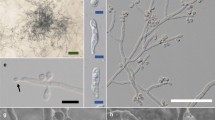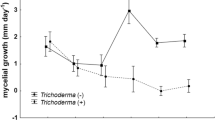Abstract
Fungi from the genus Ascochyta are generally facultative saprotrophs, which cause diseases in both monocots and dicots. Over 1 000 species belonging to this genus have been identified, 18 of which infect monocot plants from the family Poaceae. This study analyses the effects of temperature and light on the growth of selected fungi which infect monocots (A. agrostidis, A. avenae, A. brachypodii, A. desmazieri, A. digraphidis, A. ducis-aprutii, A. festucae, A. graminea, A. hordei, A. hordei var. americana, A. hordei var. europea, A. hordei var. hordei, A. melicae, A. phleina, A. skagwayensis, A. sorghi, A. stipae, A. zeicola), grown on three types of media; Potato Dextrose Agar (PDA), Coon’s agar (CN) and oatmeal agar (OMA). The fastest growth among the analyzed fungi at low temperatures was found in Ascochyta melicae, while at high temperatures it was A. zeicola. The fastest in vitro growth (average of all fungi) was observed on CN medium at 20°C (3.4 mm/day), while the lowest on OM medium at 5°C (1.0 mm/day). Radial mycelial growth in dark and the light conditions varied. On average, all isolates grew faster in the dark (3.1 mm/day) than in the light (1.9 mm/day). The greatest effect on the production of pycnidia was found for the isolates. Variation in growth and production of pycnidia depended on temperature, medium and lighting for fungi from the genus Ascochyta infecting monocots. Such variation indicates a potential occurrence of these fungi in different environments.
Similar content being viewed by others
References
Punithalingam E., Graminicolous Ascochyta species. Mycological Papers No. 142, Commonwealth Mycological Institute, Kew, England, 1979
Melnik V.A., Braun U., Hagedor G., Key to the fungi of the genus Ascochyta Lib. (Coelomycetes), Parey Buchverlag Berlin, 2000
Mathre D.E., Compendium of barley diseases. APS Press, St. Paul., 1997
Braithwaite M., Alexander B.J.R., Adams R.L.M., Nationwide survey of pests and diseases of cereal and grass seed crops in New Zealand. 2. Fungi and bacteria., Proc. 51st N.Z. Plant Protection Conf. (11–13 August 1998), The New Zealand Plant Protection Society Inc., Hamilton, 1998, 51–59
Boerema G.H.R., Pieters R., Hamers M.E.C., Check-list for scientific names of common parasitic fungi. Supplement Series 2b (additions and corrections): Fungi on field crops: Cereals and grasses, Eur. J. Plant. Pathol., 1992, 98, 1–32
Bockus W.W., Bowden R.L., Hunger R.M., Morrill W.L., Murray T.D., Smiley R.W., (eds) Compendium of Wheat Diseases and Pests: Third Edition. APS Press, St. Paul, MN, 2010
Boerema G.H., Dorenbosch M.M.J., The Phoma and Ascochyta species described by Wollenweber and Hochapfel in their study on fruit rotting, Stud. Mycol., 1973, 3, 18–19 and 38–39
Chilvers M.I., Rogers J.D., Dugan F.M., Stewart J.E., Chen W.D., Peever T.L., Didymella pisi sp nov., the teleomorph of Ascochyta pisi, Mycol. Res., 2009, 113, 391–400
Phan H.T.T., Ford R., Taylor P.W.J., Population structure of Ascochyta rabiei in Australia based on STMS fingerprints, Fungal Divers., 2003, 13, 111–129
Gorfu D., Sangchote S., Fungi associated with field pea seeds from Ethiopia and seed transmission of Ascochyta pinodes, Seed Sci. Technol., 2005, 33, 387–396
Roger C., Tivoli B., Effect of culture medium, light and temperature on sexual and asexual reproduction of four strains of Mycosphaerella pinodes, Mycol. Res., 1996,100, 304–306
Zhao Y.B.W., Grout X.Xu., Effects of temperature on germination and hyphal growth from conidia of Ramularia rhei and Ascochyta rhei, causing spot disease of rhubarb (Rheum rhapondicum), Plant Pathol., 2006, 55, 664–670
Ozkilinc H., Frenkel O., Abbo S., Shtienberg D., Sherman A., Ophir R., A comparative study of Turkish and Israeli populations of Didymella rabiei, the ascochyta pathogen of chickpea, Plant Pathol., 2010, 59, 492–503
Trapero-Casas A., Kaiser W.J., Alternative host and plant tissue for the survival, sporulation and spread of the Ascochyta blight pathogen in chickpea, Eur. J. Plant Pathol., 2009, 125, 573–587
GŁazek M., Sikora H., Mączyńska A., Krzyzińska B., Epidemic occurrence of Ascochyta graminicola on winter wheat in 2001 [Epidemiczne występowanie Ascochyta graminicola na pszenicy ozimej w 2001 roku ], Prog. Plant Prot./Post. Ochr. Roslin, 2002, 42, 897–899
Perelló A.E., Moreno M.V., Occurrence of Ascochyta hordei var. europaea on wheat (Triticum aestivum) leaves in Argentina, Australas. Plant Path., 2003, 32, 565–566
Author information
Authors and Affiliations
Corresponding author
About this article
Cite this article
Kosiada, T. In vitro growth of some species of Ascochyta Lib.. cent.eur.j.biol. 7, 1076–1083 (2012). https://doi.org/10.2478/s11535-012-0095-3
Received:
Accepted:
Published:
Issue Date:
DOI: https://doi.org/10.2478/s11535-012-0095-3




